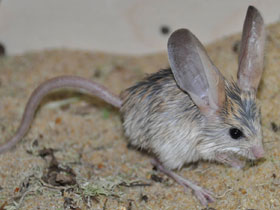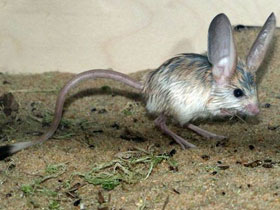The long-eared jerboa (Euchoreutes naso)
The long-eared jerboa (Euchoreutes naso) is a nocturnal mouse-like rodent with a long tail, long hind legs for jumping, and exceptionally large ears. It is distinct enough that authorities consider it to be the only member of both its genus, Euchoreutes, and subfamily, Euchoreutinae.
Habitat and lifestyle
This species of gopher tortoise is found from Mongolia to northern China. Its main food is insects. The way of life of Euchoreutes naso in nature is almost unstudied, although the animal was described by scientists 120 years ago. This is due to the fact that it lives in the harsh climatic conditions of the deserts of China and Mongolia, leads a secretive nocturnal lifestyle and is poorly caught in various traps. These rodents spend the whole day in holes dug in the sand, and only at night they come to the surface to eat. Therefore, there is no quite certain data on the number of marmosets in nature. It is only clear that the density of animals everywhere is very low, although the habitat is very extensive.
Distinctive features
Euchoreutes naso - a small animal, the body length of which varies from 80 to 90 mm, and it weighs 24-35 grams. It is distinguished from other species by an elongated conical head, widened at the back of the head, and ears so large that if they are pulled back they reach the end of the body. Euchoreutes naso is grey above, with an admixture of reddish colour, especially near the base of the tail; but its sides and underside are white. Euchoreutes naso has a very long tail: 157-162 mm. The tassel of long hairs at the end of the tail is well developed, but the long hairs grow round the tail shaft without forming a flat "banner"; the tassel is white at the base, black in the middle part and its end is white.
External features
The head of this animal has a conical elongated shape, unusual for gnats, with a strongly forward protruding elongated and blunted at the end of the pig-shaped snout. Its ears are of enormous size, reaching the sacral region with their tops. The length of its ears reaches 5 cm, which is a little more than half the length of its body. Thus, this animal deserves the full right to be called "the biggest-eared animal" on the planet. The vibrissae are long, almost reaching the base of the tail with their ends. The length of the hind limbs is 4 times longer than the length of the fore limbs. The inner toe of the forelimb is relatively well developed and equipped with a long curved claw with a sharp apex. The hind limbs are narrow and very much elongated, with three long middle fingers and two much shorter lateral fingers, but the middle finger only just extending beyond the ends of the neighbouring fingers (2nd and 4th); the pads at the ends of the fingers are strongly developed and divided into lobes. At the base of the lateral fingers (1st and 5th) there are small tubercles ("calluses") on the lower surface. Scallops of stiff hair border the toes, which helps the animals to move on loose ground without falling through. The relative length of the tibia of Euchoreutes naso is the longest in the family, i.e. it is the longest-legged among the gerbils. The tail of this charming rodent is twice as long as its body. The tassel at the end of the tail is coloured black at the base and white at the distal part, but it is not flattened. The hair cover is tall, dense, and soft.
Habitat
Euchoreutes naso is perfectly adapted to desert life. In Mongolia it inhabits sandy valleys overgrown with low bushes of saxaul, though by its appearance and especially by the structure of its hind foot it could be mistaken for an inhabitant of clay or rubbly deserts. In Mongolia it inhabits sandy valleys overgrown with low saxaul bushes.
Conservation
The long-eared jerboa was identified as one of the top-10 "focal species" in 2007 by the Evolutionarily Distinct and Globally Endangered (EDGE) project.
In 2007 the Zoological Society of London EDGE of Existence Programme sent a researcher to study human impact on its environment. The study returned with video footage that has been noted as the "first time" the creature has been "recorded on camera". This has helped to start a campaign to protect them.

















































